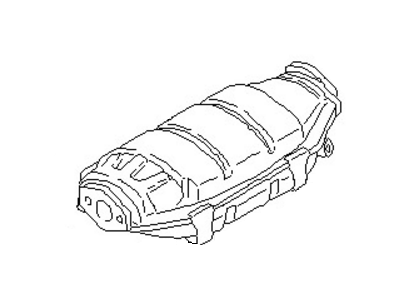×
- Hello
- Login or Register
- Quick Links
- Live Chat
- Track Order
- Parts Availability
- RMA
- Help Center
- Contact Us
- Shop for
- Nissan Parts
- Nissan Accessories

My Garage
My Account
Cart
Genuine Nissan 240SX Catalytic Converter
Cat. Converter- Select Vehicle by Model
- Select Vehicle by VIN
Select Vehicle by Model
orMake
Model
Year
Select Vehicle by VIN
For the most accurate results, select vehicle by your VIN (Vehicle Identification Number).
4 Catalytic Converters found
Nissan 240SX Catalytic Converter
If you need any OEM Nissan 240SX Catalytic Converter, feel free to choose them out of our huge selection of genuine Nissan 240SX Catalytic Converter. All our parts are offered at unbeatable prices and are supported by the manufacturer's warranty. In addition, we offer quick shipping to have your parts delivered to your door step in a matter of days.
Nissan 240SX Catalytic Converter Parts Questions & Experts Answers
- Q: What is the purpose of the catalytic converter in the exhaust system on Nissan 240sx?A:The catalytic converter is a muffler-like container built into the exhaust system to aid in the reduction of exhaust emissions. It consists of individual pellets or a honeycomb monolithic substrate coated with a noble metal such as platinum, palladium, rhodium or a combination. When the exhaust gases come into contact with the catalyst, a chemical reaction occurs which reduces the pollutants into harmless substances like water and carbon dioxide. There are two types of catalytic converters: an oxidizing type used on all models before 1980, and a three-way converter capable of reducing HG, CO and NOx emissions. The three-way converter requires precise oxygen control and is used only in cars equipped with an oxygen sensor system. All models with the three-way converter have an oxygen sensor warning light on the dashboard, which illuminates at the first 30,000 mile interval, signaling the need for oxygen sensor replacement. The oxygen sensor is part of the Mixture Ratio Feedback System, which uses the three-way converter as one of its major components. No regular maintenance is required for the catalytic converter system, except for periodic replacement of the Air Induction System filter. The Air Induction System is used to supply the catalytic converter with fresh air. Oxygen present in the air is used in the oxidation process. Precautions include using only unleaded fuel, avoiding prolonged idling, not disconnecting any of the spark plug leads while the engine is running, and making engine compression checks as quickly as possible. At present, there is no known way to reliably test catalytic converter operation in the field. Most converter problems can be traced to fuel or ignition system problems which cause unusually high emissions. As long as you avoid severe overheating and the use of leaded fuels it is reasonably safe to assume that the converter is working properly.














